Risk Management: Investment Decision & Supply Chain Analysis
VerifiedAdded on 2023/06/11
|11
|1810
|235
Homework Assignment
AI Summary
This assignment provides solutions to questions related to risk management. It defines pure risk, direct losses, and catastrophic loss events, and identifies methods of risk protection and hazards. It analyzes risks in a restaurant's supply chain, offering mitigation strategies for each stage, from harvesting to customer interaction. The assignment also evaluates two investment projects using payback period and net present value (NPV) methods, recommending the better option based on financial analysis. Furthermore, it discusses the advantages of compound interest, the steps in managing risk (identification, analysis, assessment, treatment, and monitoring), and explains market and liquidity risks with examples. The document concludes by addressing risks related to over and under estimation of drinks, and the risk of poor quality supplied beverages in a restaurant setting, along with potential solutions. Desklib offers a wealth of similar solved assignments and past papers to aid students in their studies.
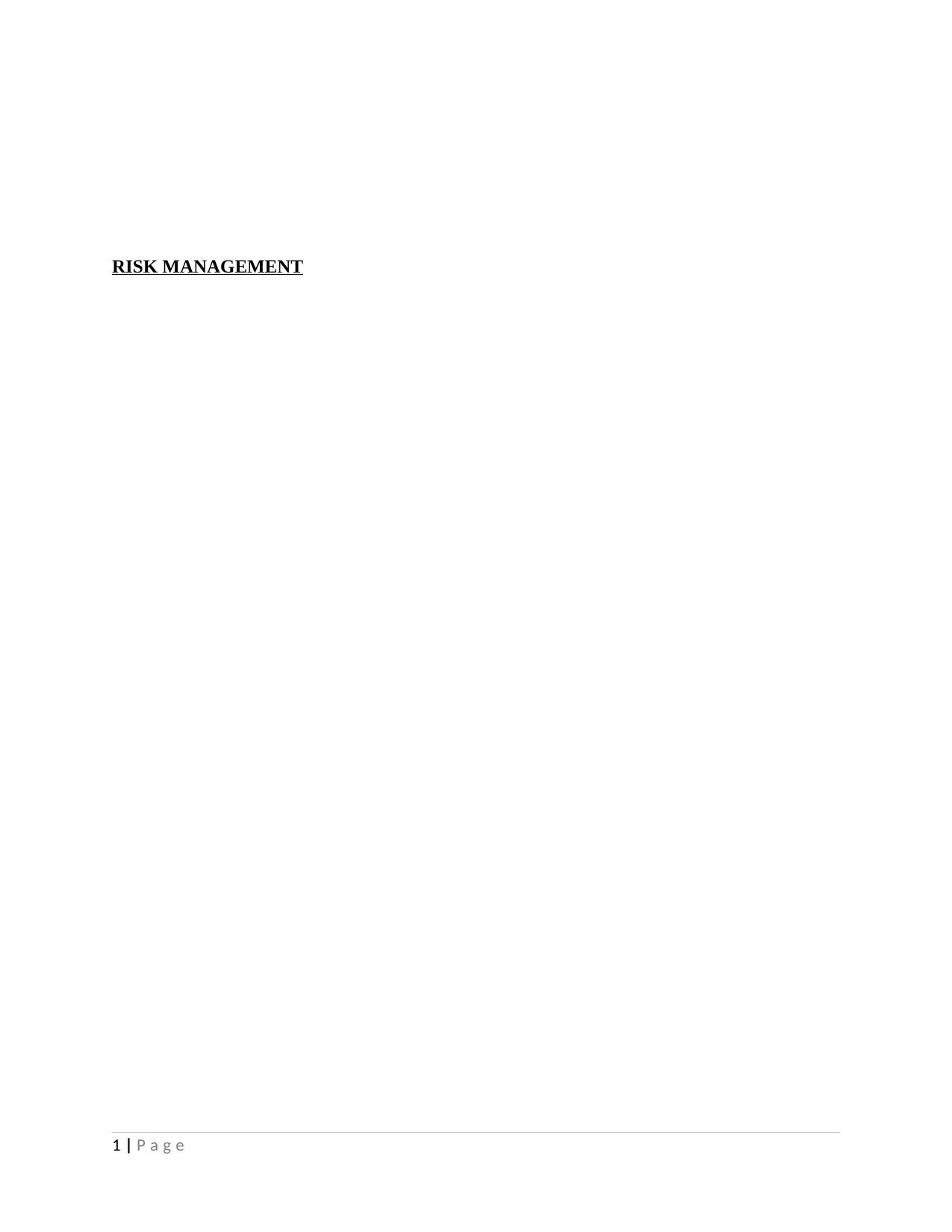
RISK MANAGEMENT
1 | P a g e
1 | P a g e
Paraphrase This Document
Need a fresh take? Get an instant paraphrase of this document with our AI Paraphraser
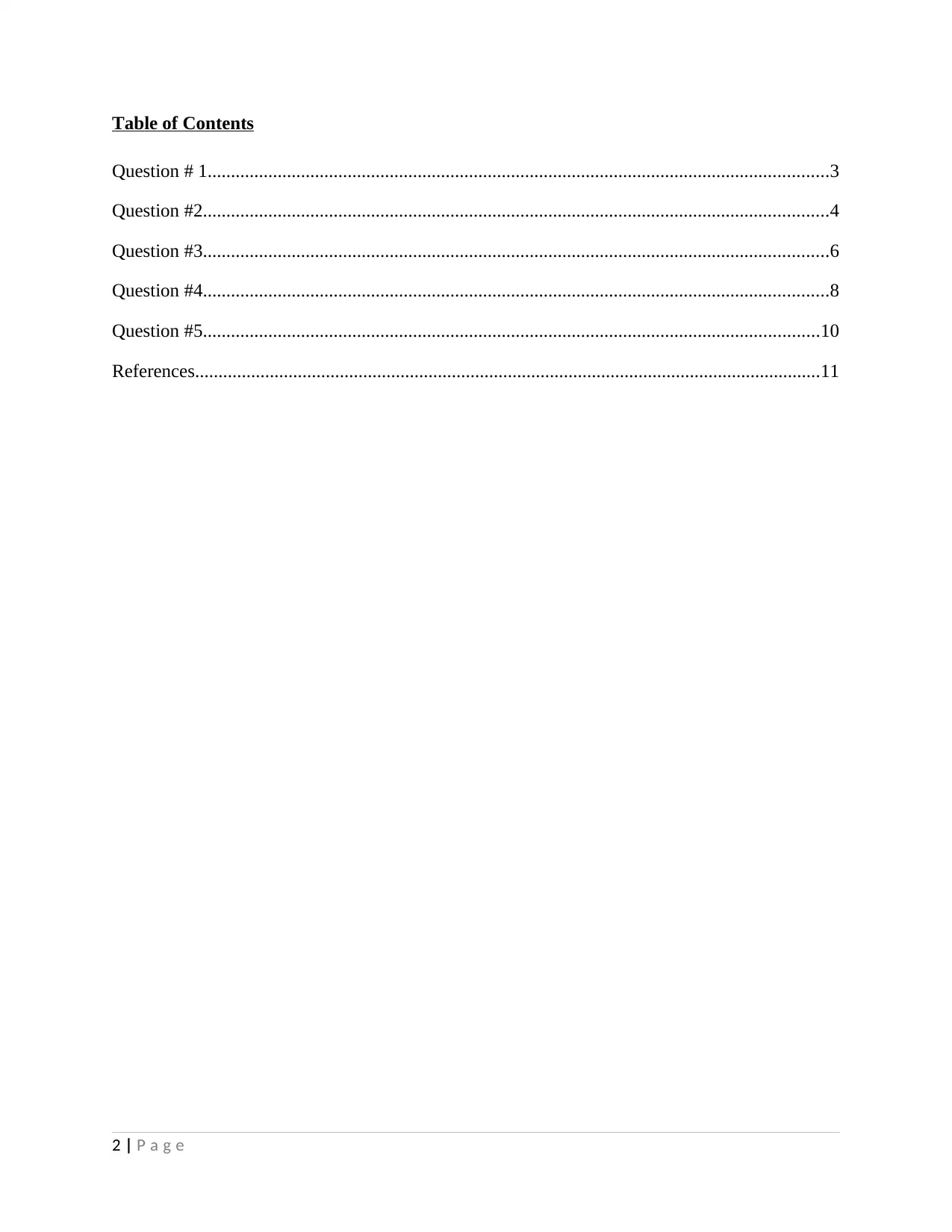
Table of Contents
Question # 1.....................................................................................................................................3
Question #2......................................................................................................................................4
Question #3......................................................................................................................................6
Question #4......................................................................................................................................8
Question #5....................................................................................................................................10
References......................................................................................................................................11
2 | P a g e
Question # 1.....................................................................................................................................3
Question #2......................................................................................................................................4
Question #3......................................................................................................................................6
Question #4......................................................................................................................................8
Question #5....................................................................................................................................10
References......................................................................................................................................11
2 | P a g e
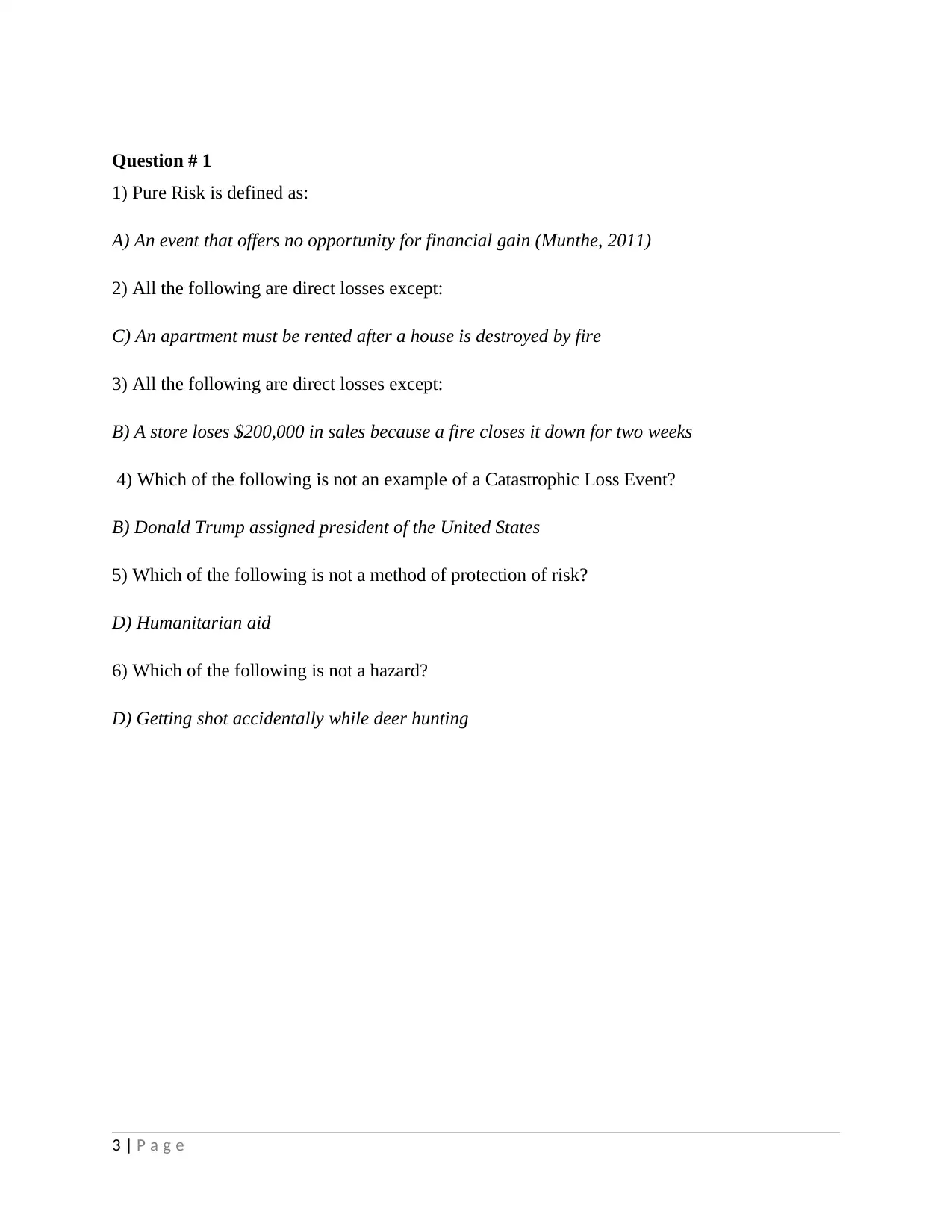
Question # 1
1) Pure Risk is defined as:
A) An event that offers no opportunity for financial gain (Munthe, 2011)
2) All the following are direct losses except:
C) An apartment must be rented after a house is destroyed by fire
3) All the following are direct losses except:
B) A store loses $200,000 in sales because a fire closes it down for two weeks
4) Which of the following is not an example of a Catastrophic Loss Event?
B) Donald Trump assigned president of the United States
5) Which of the following is not a method of protection of risk?
D) Humanitarian aid
6) Which of the following is not a hazard?
D) Getting shot accidentally while deer hunting
3 | P a g e
1) Pure Risk is defined as:
A) An event that offers no opportunity for financial gain (Munthe, 2011)
2) All the following are direct losses except:
C) An apartment must be rented after a house is destroyed by fire
3) All the following are direct losses except:
B) A store loses $200,000 in sales because a fire closes it down for two weeks
4) Which of the following is not an example of a Catastrophic Loss Event?
B) Donald Trump assigned president of the United States
5) Which of the following is not a method of protection of risk?
D) Humanitarian aid
6) Which of the following is not a hazard?
D) Getting shot accidentally while deer hunting
3 | P a g e
⊘ This is a preview!⊘
Do you want full access?
Subscribe today to unlock all pages.

Trusted by 1+ million students worldwide
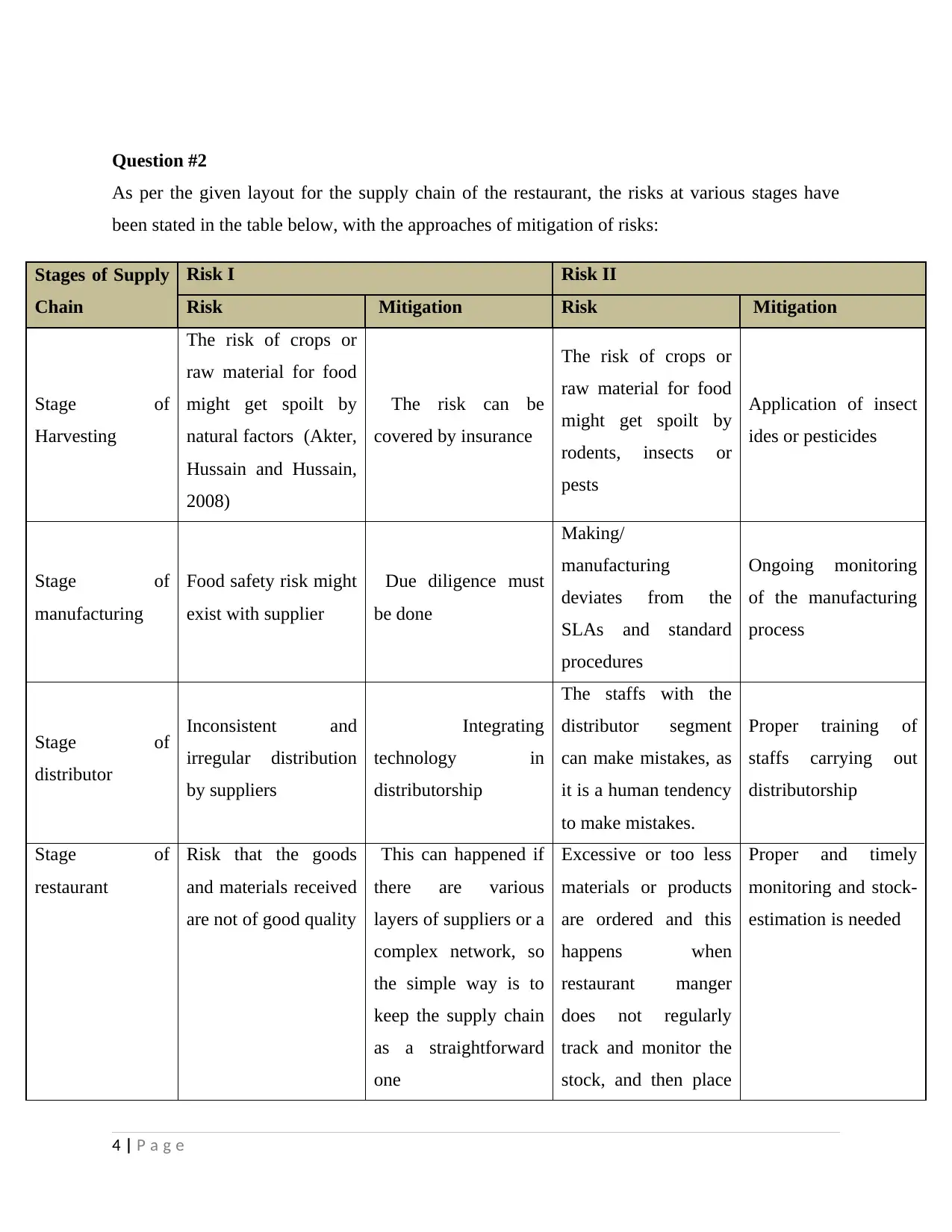
Question #2
As per the given layout for the supply chain of the restaurant, the risks at various stages have
been stated in the table below, with the approaches of mitigation of risks:
Stages of Supply
Chain
Risk I Risk II
Risk Mitigation Risk Mitigation
Stage of
Harvesting
The risk of crops or
raw material for food
might get spoilt by
natural factors (Akter,
Hussain and Hussain,
2008)
The risk can be
covered by insurance
The risk of crops or
raw material for food
might get spoilt by
rodents, insects or
pests
Application of insect
ides or pesticides
Stage of
manufacturing
Food safety risk might
exist with supplier
Due diligence must
be done
Making/
manufacturing
deviates from the
SLAs and standard
procedures
Ongoing monitoring
of the manufacturing
process
Stage of
distributor
Inconsistent and
irregular distribution
by suppliers
Integrating
technology in
distributorship
The staffs with the
distributor segment
can make mistakes, as
it is a human tendency
to make mistakes.
Proper training of
staffs carrying out
distributorship
Stage of
restaurant
Risk that the goods
and materials received
are not of good quality
This can happened if
there are various
layers of suppliers or a
complex network, so
the simple way is to
keep the supply chain
as a straightforward
one
Excessive or too less
materials or products
are ordered and this
happens when
restaurant manger
does not regularly
track and monitor the
stock, and then place
Proper and timely
monitoring and stock-
estimation is needed
4 | P a g e
As per the given layout for the supply chain of the restaurant, the risks at various stages have
been stated in the table below, with the approaches of mitigation of risks:
Stages of Supply
Chain
Risk I Risk II
Risk Mitigation Risk Mitigation
Stage of
Harvesting
The risk of crops or
raw material for food
might get spoilt by
natural factors (Akter,
Hussain and Hussain,
2008)
The risk can be
covered by insurance
The risk of crops or
raw material for food
might get spoilt by
rodents, insects or
pests
Application of insect
ides or pesticides
Stage of
manufacturing
Food safety risk might
exist with supplier
Due diligence must
be done
Making/
manufacturing
deviates from the
SLAs and standard
procedures
Ongoing monitoring
of the manufacturing
process
Stage of
distributor
Inconsistent and
irregular distribution
by suppliers
Integrating
technology in
distributorship
The staffs with the
distributor segment
can make mistakes, as
it is a human tendency
to make mistakes.
Proper training of
staffs carrying out
distributorship
Stage of
restaurant
Risk that the goods
and materials received
are not of good quality
This can happened if
there are various
layers of suppliers or a
complex network, so
the simple way is to
keep the supply chain
as a straightforward
one
Excessive or too less
materials or products
are ordered and this
happens when
restaurant manger
does not regularly
track and monitor the
stock, and then place
Proper and timely
monitoring and stock-
estimation is needed
4 | P a g e
Paraphrase This Document
Need a fresh take? Get an instant paraphrase of this document with our AI Paraphraser
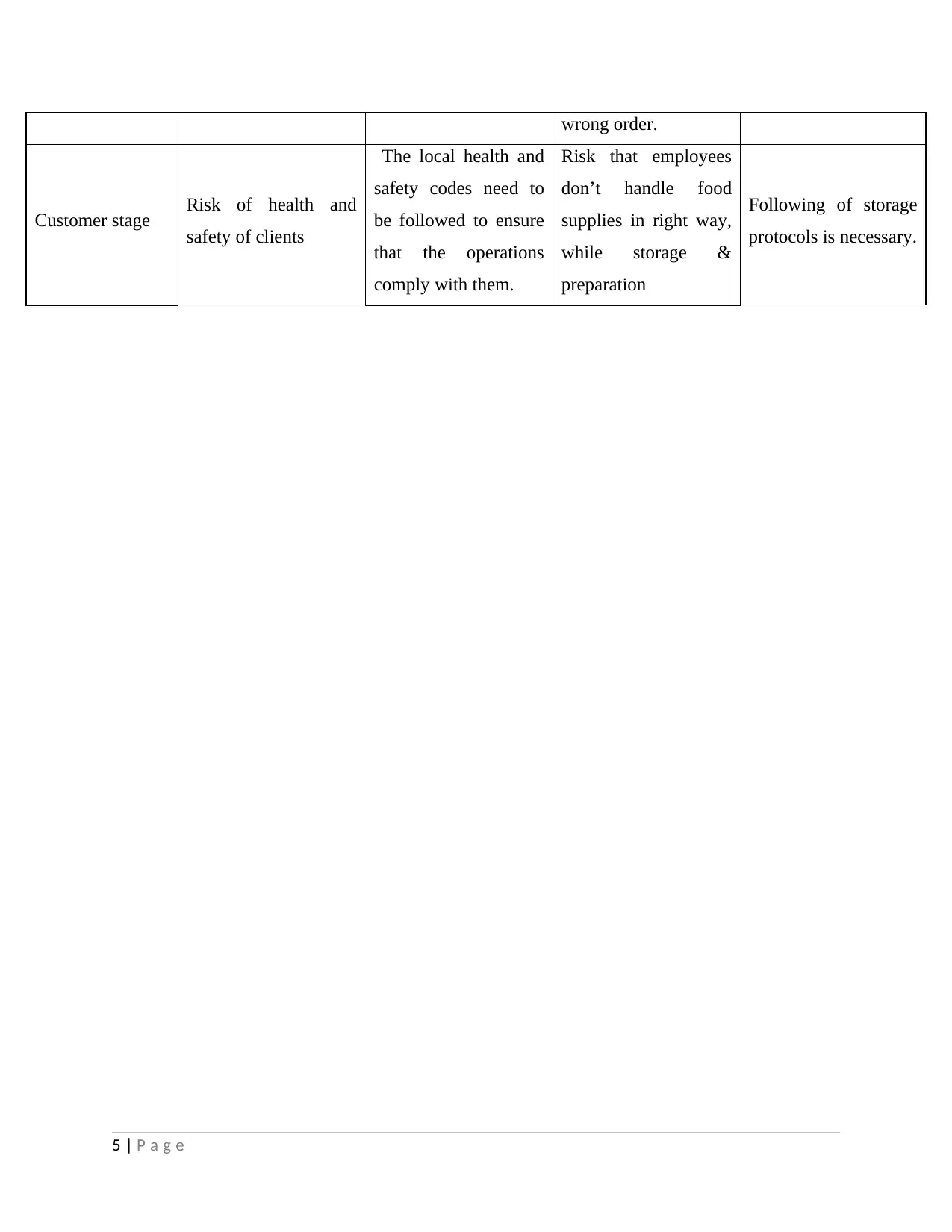
wrong order.
Customer stage Risk of health and
safety of clients
The local health and
safety codes need to
be followed to ensure
that the operations
comply with them.
Risk that employees
don’t handle food
supplies in right way,
while storage &
preparation
Following of storage
protocols is necessary.
5 | P a g e
Customer stage Risk of health and
safety of clients
The local health and
safety codes need to
be followed to ensure
that the operations
comply with them.
Risk that employees
don’t handle food
supplies in right way,
while storage &
preparation
Following of storage
protocols is necessary.
5 | P a g e
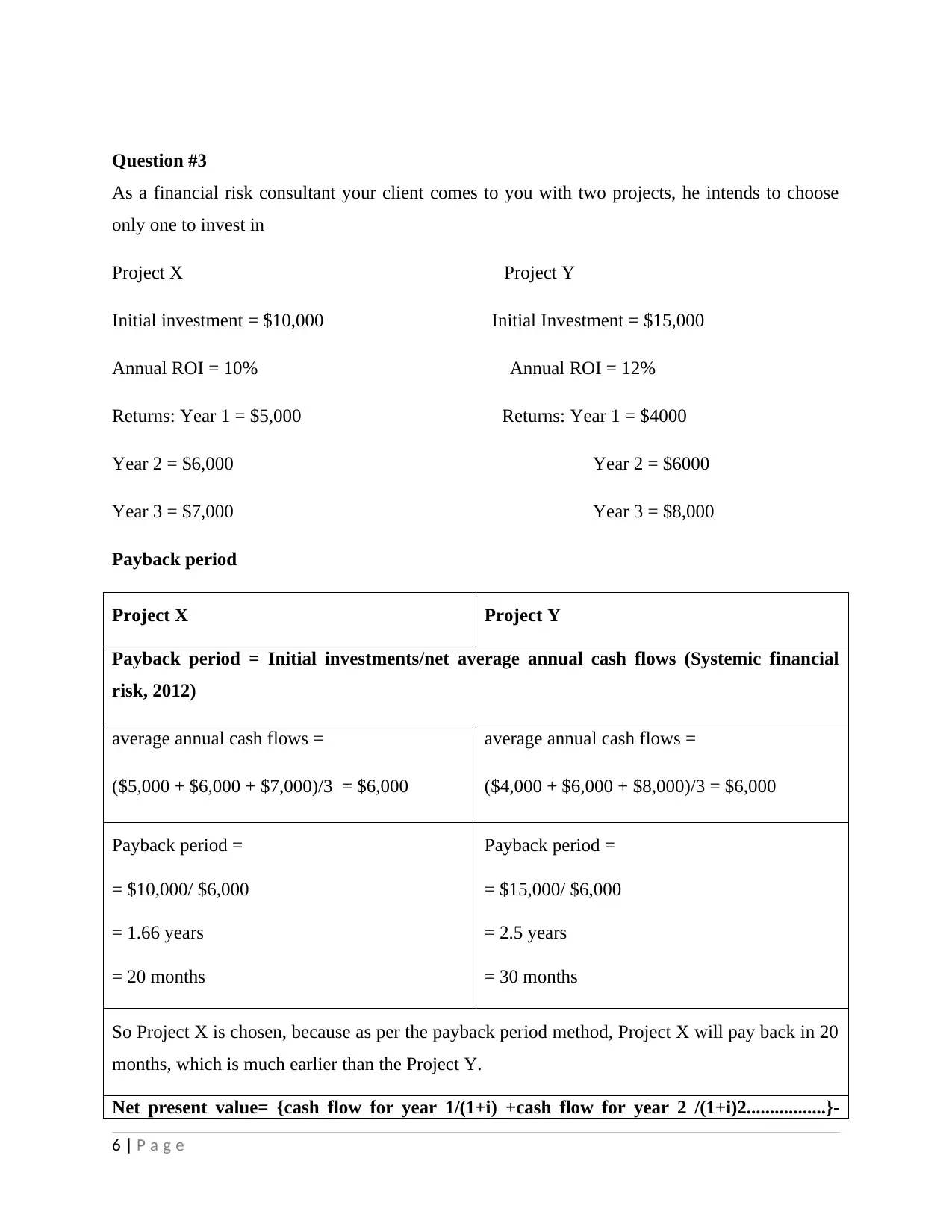
Question #3
As a financial risk consultant your client comes to you with two projects, he intends to choose
only one to invest in
Project X Project Y
Initial investment = $10,000 Initial Investment = $15,000
Annual ROI = 10% Annual ROI = 12%
Returns: Year 1 = $5,000 Returns: Year 1 = $4000
Year 2 = $6,000 Year 2 = $6000
Year 3 = $7,000 Year 3 = $8,000
Payback period
Project X Project Y
Payback period = Initial investments/net average annual cash flows (Systemic financial
risk, 2012)
average annual cash flows =
($5,000 + $6,000 + $7,000)/3 = $6,000
average annual cash flows =
($4,000 + $6,000 + $8,000)/3 = $6,000
Payback period =
= $10,000/ $6,000
= 1.66 years
= 20 months
Payback period =
= $15,000/ $6,000
= 2.5 years
= 30 months
So Project X is chosen, because as per the payback period method, Project X will pay back in 20
months, which is much earlier than the Project Y.
Net present value= {cash flow for year 1/(1+i) +cash flow for year 2 /(1+i)2.................}-
6 | P a g e
As a financial risk consultant your client comes to you with two projects, he intends to choose
only one to invest in
Project X Project Y
Initial investment = $10,000 Initial Investment = $15,000
Annual ROI = 10% Annual ROI = 12%
Returns: Year 1 = $5,000 Returns: Year 1 = $4000
Year 2 = $6,000 Year 2 = $6000
Year 3 = $7,000 Year 3 = $8,000
Payback period
Project X Project Y
Payback period = Initial investments/net average annual cash flows (Systemic financial
risk, 2012)
average annual cash flows =
($5,000 + $6,000 + $7,000)/3 = $6,000
average annual cash flows =
($4,000 + $6,000 + $8,000)/3 = $6,000
Payback period =
= $10,000/ $6,000
= 1.66 years
= 20 months
Payback period =
= $15,000/ $6,000
= 2.5 years
= 30 months
So Project X is chosen, because as per the payback period method, Project X will pay back in 20
months, which is much earlier than the Project Y.
Net present value= {cash flow for year 1/(1+i) +cash flow for year 2 /(1+i)2.................}-
6 | P a g e
⊘ This is a preview!⊘
Do you want full access?
Subscribe today to unlock all pages.

Trusted by 1+ million students worldwide
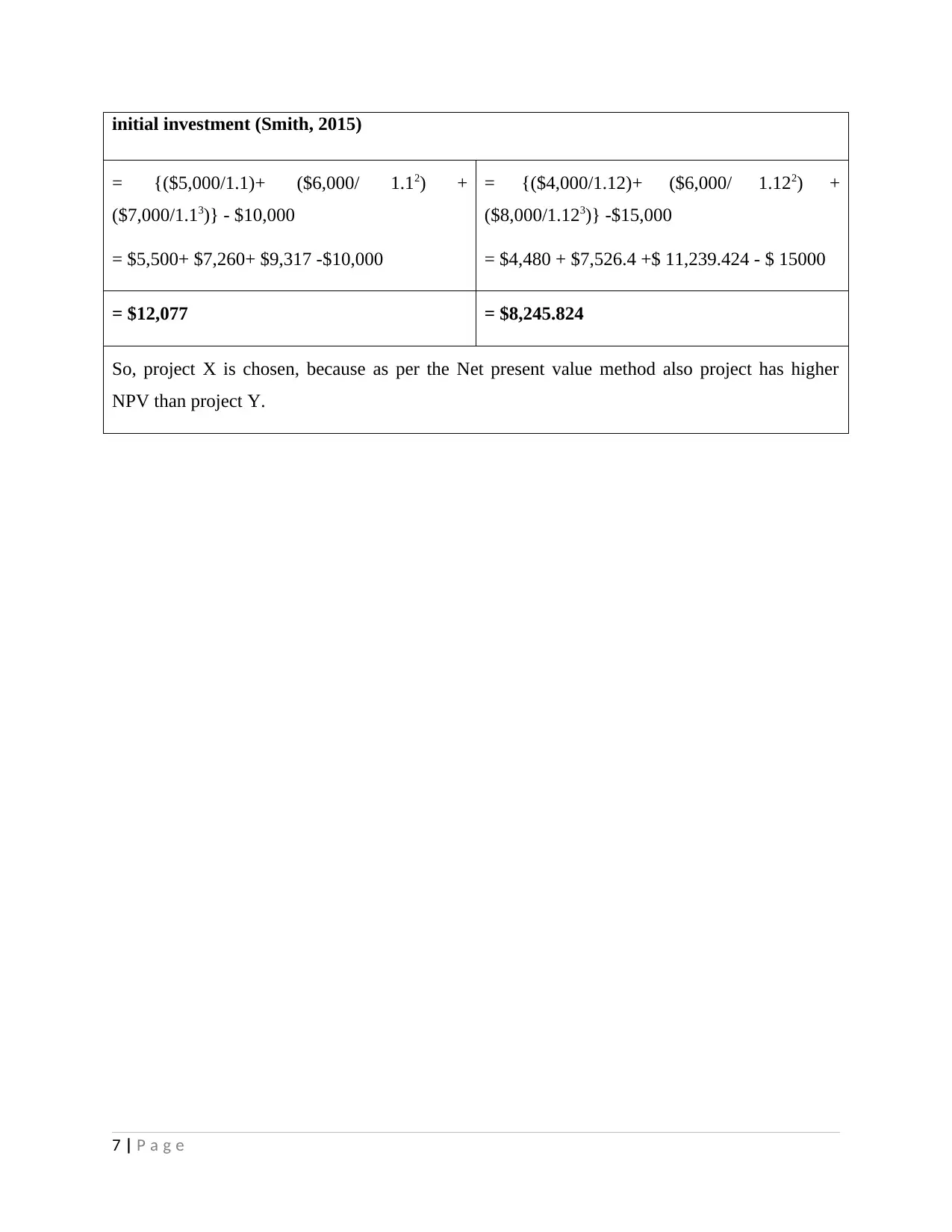
initial investment (Smith, 2015)
= {($5,000/1.1)+ ($6,000/ 1.12) +
($7,000/1.13)} - $10,000
= $5,500+ $7,260+ $9,317 -$10,000
= {($4,000/1.12)+ ($6,000/ 1.122) +
($8,000/1.123)} -$15,000
= $4,480 + $7,526.4 +$ 11,239.424 - $ 15000
= $12,077 = $8,245.824
So, project X is chosen, because as per the Net present value method also project has higher
NPV than project Y.
7 | P a g e
= {($5,000/1.1)+ ($6,000/ 1.12) +
($7,000/1.13)} - $10,000
= $5,500+ $7,260+ $9,317 -$10,000
= {($4,000/1.12)+ ($6,000/ 1.122) +
($8,000/1.123)} -$15,000
= $4,480 + $7,526.4 +$ 11,239.424 - $ 15000
= $12,077 = $8,245.824
So, project X is chosen, because as per the Net present value method also project has higher
NPV than project Y.
7 | P a g e
Paraphrase This Document
Need a fresh take? Get an instant paraphrase of this document with our AI Paraphraser
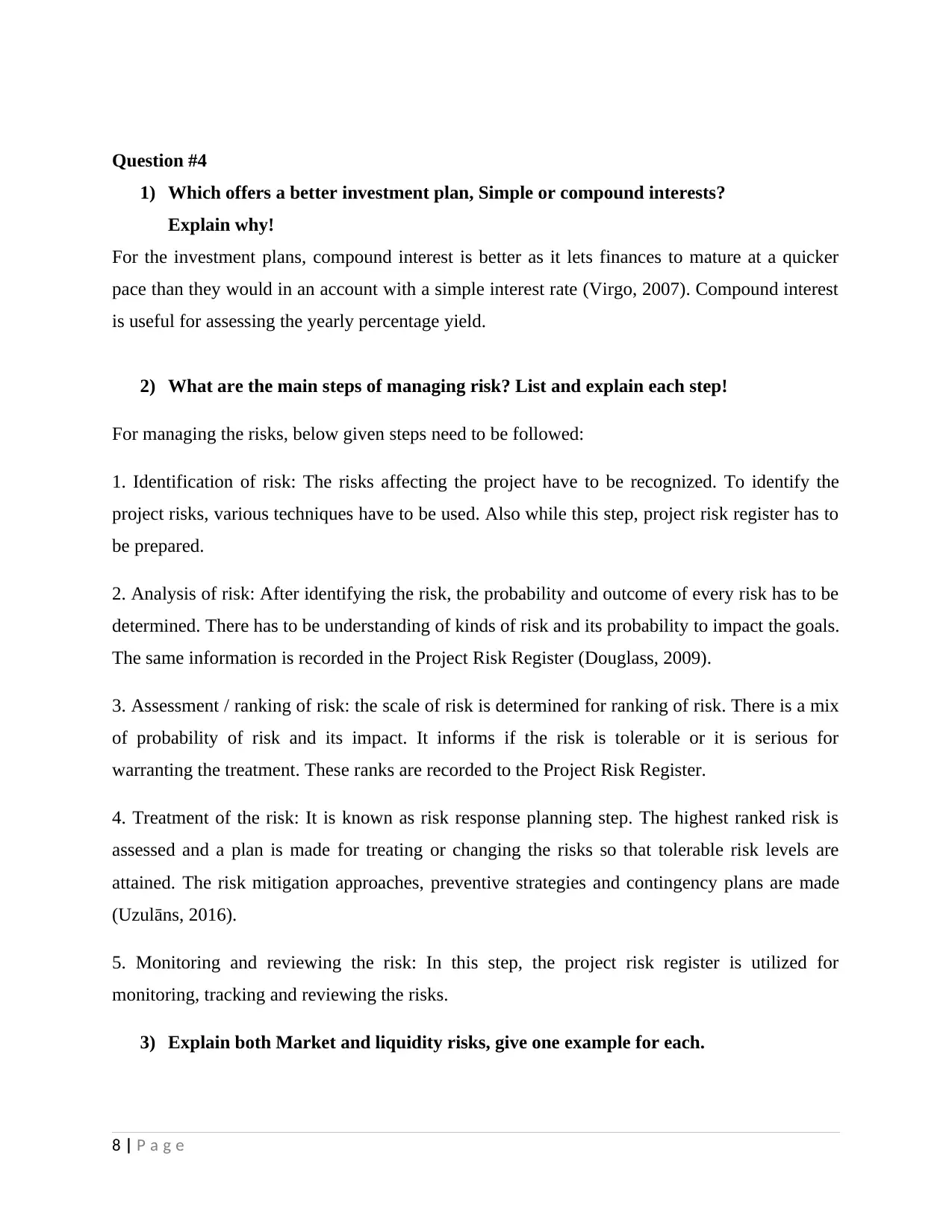
Question #4
1) Which offers a better investment plan, Simple or compound interests?
Explain why!
For the investment plans, compound interest is better as it lets finances to mature at a quicker
pace than they would in an account with a simple interest rate (Virgo, 2007). Compound interest
is useful for assessing the yearly percentage yield.
2) What are the main steps of managing risk? List and explain each step!
For managing the risks, below given steps need to be followed:
1. Identification of risk: The risks affecting the project have to be recognized. To identify the
project risks, various techniques have to be used. Also while this step, project risk register has to
be prepared.
2. Analysis of risk: After identifying the risk, the probability and outcome of every risk has to be
determined. There has to be understanding of kinds of risk and its probability to impact the goals.
The same information is recorded in the Project Risk Register (Douglass, 2009).
3. Assessment / ranking of risk: the scale of risk is determined for ranking of risk. There is a mix
of probability of risk and its impact. It informs if the risk is tolerable or it is serious for
warranting the treatment. These ranks are recorded to the Project Risk Register.
4. Treatment of the risk: It is known as risk response planning step. The highest ranked risk is
assessed and a plan is made for treating or changing the risks so that tolerable risk levels are
attained. The risk mitigation approaches, preventive strategies and contingency plans are made
(Uzulāns, 2016).
5. Monitoring and reviewing the risk: In this step, the project risk register is utilized for
monitoring, tracking and reviewing the risks.
3) Explain both Market and liquidity risks, give one example for each.
8 | P a g e
1) Which offers a better investment plan, Simple or compound interests?
Explain why!
For the investment plans, compound interest is better as it lets finances to mature at a quicker
pace than they would in an account with a simple interest rate (Virgo, 2007). Compound interest
is useful for assessing the yearly percentage yield.
2) What are the main steps of managing risk? List and explain each step!
For managing the risks, below given steps need to be followed:
1. Identification of risk: The risks affecting the project have to be recognized. To identify the
project risks, various techniques have to be used. Also while this step, project risk register has to
be prepared.
2. Analysis of risk: After identifying the risk, the probability and outcome of every risk has to be
determined. There has to be understanding of kinds of risk and its probability to impact the goals.
The same information is recorded in the Project Risk Register (Douglass, 2009).
3. Assessment / ranking of risk: the scale of risk is determined for ranking of risk. There is a mix
of probability of risk and its impact. It informs if the risk is tolerable or it is serious for
warranting the treatment. These ranks are recorded to the Project Risk Register.
4. Treatment of the risk: It is known as risk response planning step. The highest ranked risk is
assessed and a plan is made for treating or changing the risks so that tolerable risk levels are
attained. The risk mitigation approaches, preventive strategies and contingency plans are made
(Uzulāns, 2016).
5. Monitoring and reviewing the risk: In this step, the project risk register is utilized for
monitoring, tracking and reviewing the risks.
3) Explain both Market and liquidity risks, give one example for each.
8 | P a g e
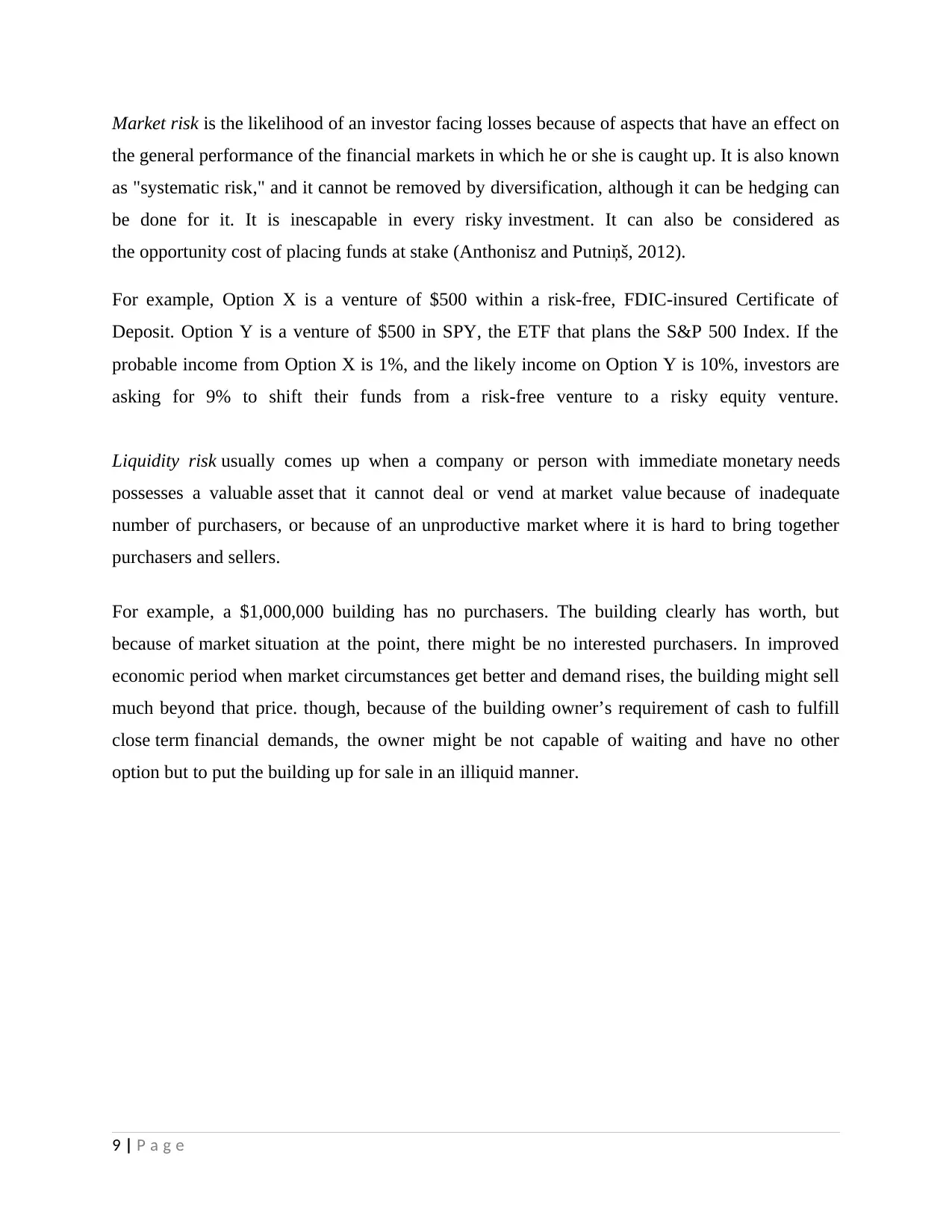
Market risk is the likelihood of an investor facing losses because of aspects that have an effect on
the general performance of the financial markets in which he or she is caught up. It is also known
as "systematic risk," and it cannot be removed by diversification, although it can be hedging can
be done for it. It is inescapable in every risky investment. It can also be considered as
the opportunity cost of placing funds at stake (Anthonisz and Putniņš, 2012).
For example, Option X is a venture of $500 within a risk-free, FDIC-insured Certificate of
Deposit. Option Y is a venture of $500 in SPY, the ETF that plans the S&P 500 Index. If the
probable income from Option X is 1%, and the likely income on Option Y is 10%, investors are
asking for 9% to shift their funds from a risk-free venture to a risky equity venture.
Liquidity risk usually comes up when a company or person with immediate monetary needs
possesses a valuable asset that it cannot deal or vend at market value because of inadequate
number of purchasers, or because of an unproductive market where it is hard to bring together
purchasers and sellers.
For example, a $1,000,000 building has no purchasers. The building clearly has worth, but
because of market situation at the point, there might be no interested purchasers. In improved
economic period when market circumstances get better and demand rises, the building might sell
much beyond that price. though, because of the building owner’s requirement of cash to fulfill
close term financial demands, the owner might be not capable of waiting and have no other
option but to put the building up for sale in an illiquid manner.
9 | P a g e
the general performance of the financial markets in which he or she is caught up. It is also known
as "systematic risk," and it cannot be removed by diversification, although it can be hedging can
be done for it. It is inescapable in every risky investment. It can also be considered as
the opportunity cost of placing funds at stake (Anthonisz and Putniņš, 2012).
For example, Option X is a venture of $500 within a risk-free, FDIC-insured Certificate of
Deposit. Option Y is a venture of $500 in SPY, the ETF that plans the S&P 500 Index. If the
probable income from Option X is 1%, and the likely income on Option Y is 10%, investors are
asking for 9% to shift their funds from a risk-free venture to a risky equity venture.
Liquidity risk usually comes up when a company or person with immediate monetary needs
possesses a valuable asset that it cannot deal or vend at market value because of inadequate
number of purchasers, or because of an unproductive market where it is hard to bring together
purchasers and sellers.
For example, a $1,000,000 building has no purchasers. The building clearly has worth, but
because of market situation at the point, there might be no interested purchasers. In improved
economic period when market circumstances get better and demand rises, the building might sell
much beyond that price. though, because of the building owner’s requirement of cash to fulfill
close term financial demands, the owner might be not capable of waiting and have no other
option but to put the building up for sale in an illiquid manner.
9 | P a g e
⊘ This is a preview!⊘
Do you want full access?
Subscribe today to unlock all pages.

Trusted by 1+ million students worldwide
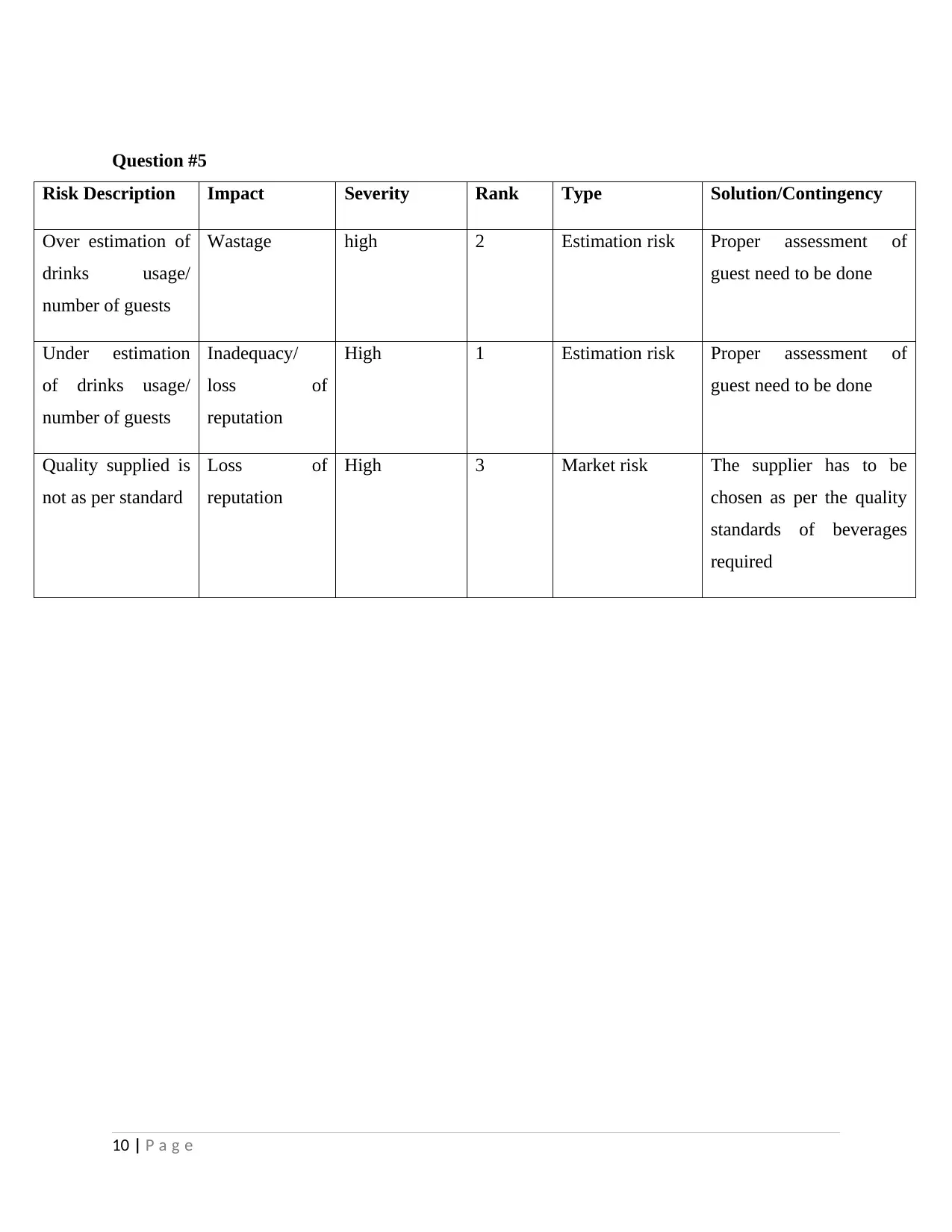
Question #5
Risk Description Impact Severity Rank Type Solution/Contingency
Over estimation of
drinks usage/
number of guests
Wastage high 2 Estimation risk Proper assessment of
guest need to be done
Under estimation
of drinks usage/
number of guests
Inadequacy/
loss of
reputation
High 1 Estimation risk Proper assessment of
guest need to be done
Quality supplied is
not as per standard
Loss of
reputation
High 3 Market risk The supplier has to be
chosen as per the quality
standards of beverages
required
10 | P a g e
Risk Description Impact Severity Rank Type Solution/Contingency
Over estimation of
drinks usage/
number of guests
Wastage high 2 Estimation risk Proper assessment of
guest need to be done
Under estimation
of drinks usage/
number of guests
Inadequacy/
loss of
reputation
High 1 Estimation risk Proper assessment of
guest need to be done
Quality supplied is
not as per standard
Loss of
reputation
High 3 Market risk The supplier has to be
chosen as per the quality
standards of beverages
required
10 | P a g e
Paraphrase This Document
Need a fresh take? Get an instant paraphrase of this document with our AI Paraphraser
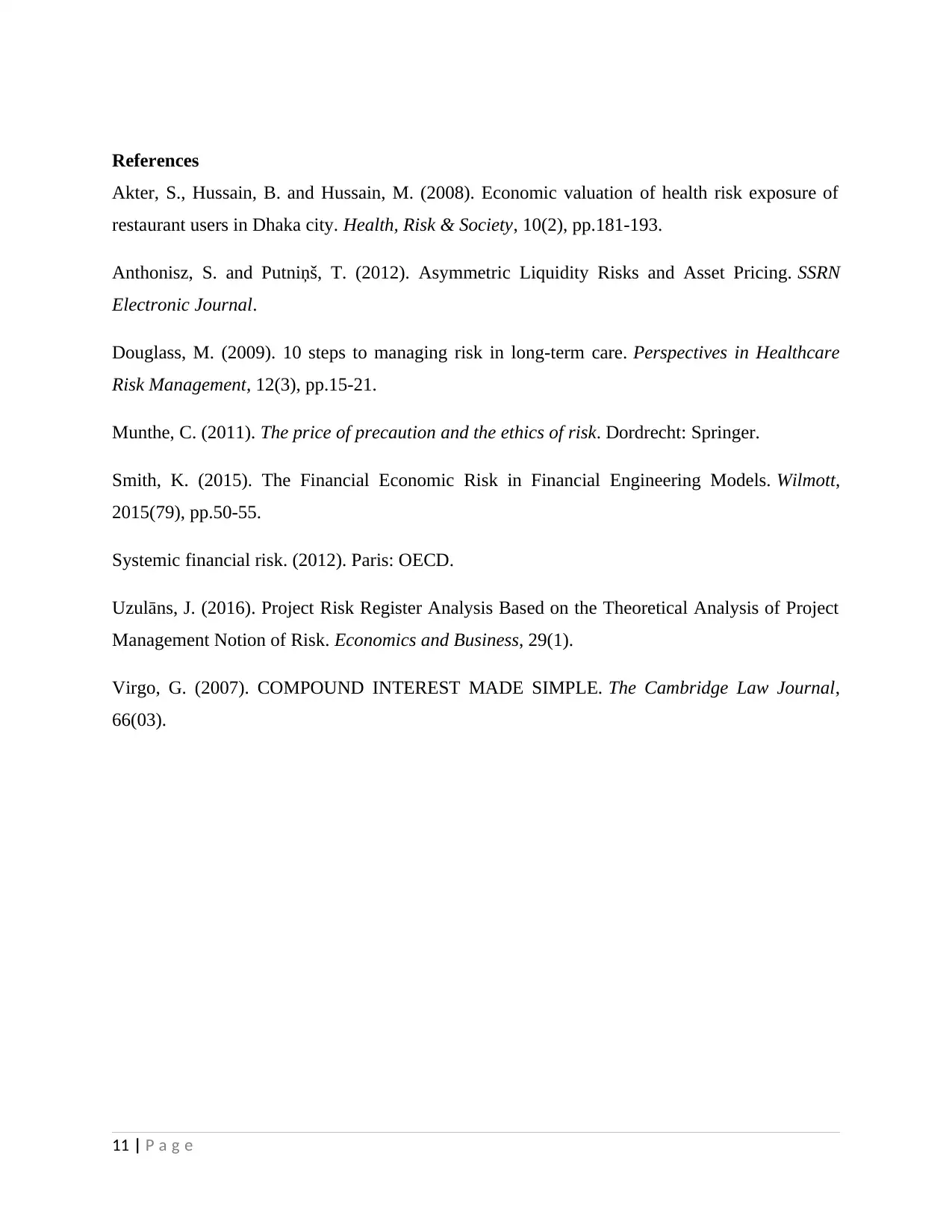
References
Akter, S., Hussain, B. and Hussain, M. (2008). Economic valuation of health risk exposure of
restaurant users in Dhaka city. Health, Risk & Society, 10(2), pp.181-193.
Anthonisz, S. and Putniņš, T. (2012). Asymmetric Liquidity Risks and Asset Pricing. SSRN
Electronic Journal.
Douglass, M. (2009). 10 steps to managing risk in long-term care. Perspectives in Healthcare
Risk Management, 12(3), pp.15-21.
Munthe, C. (2011). The price of precaution and the ethics of risk. Dordrecht: Springer.
Smith, K. (2015). The Financial Economic Risk in Financial Engineering Models. Wilmott,
2015(79), pp.50-55.
Systemic financial risk. (2012). Paris: OECD.
Uzulāns, J. (2016). Project Risk Register Analysis Based on the Theoretical Analysis of Project
Management Notion of Risk. Economics and Business, 29(1).
Virgo, G. (2007). COMPOUND INTEREST MADE SIMPLE. The Cambridge Law Journal,
66(03).
11 | P a g e
Akter, S., Hussain, B. and Hussain, M. (2008). Economic valuation of health risk exposure of
restaurant users in Dhaka city. Health, Risk & Society, 10(2), pp.181-193.
Anthonisz, S. and Putniņš, T. (2012). Asymmetric Liquidity Risks and Asset Pricing. SSRN
Electronic Journal.
Douglass, M. (2009). 10 steps to managing risk in long-term care. Perspectives in Healthcare
Risk Management, 12(3), pp.15-21.
Munthe, C. (2011). The price of precaution and the ethics of risk. Dordrecht: Springer.
Smith, K. (2015). The Financial Economic Risk in Financial Engineering Models. Wilmott,
2015(79), pp.50-55.
Systemic financial risk. (2012). Paris: OECD.
Uzulāns, J. (2016). Project Risk Register Analysis Based on the Theoretical Analysis of Project
Management Notion of Risk. Economics and Business, 29(1).
Virgo, G. (2007). COMPOUND INTEREST MADE SIMPLE. The Cambridge Law Journal,
66(03).
11 | P a g e
1 out of 11
Your All-in-One AI-Powered Toolkit for Academic Success.
+13062052269
info@desklib.com
Available 24*7 on WhatsApp / Email
![[object Object]](/_next/static/media/star-bottom.7253800d.svg)
Unlock your academic potential
Copyright © 2020–2025 A2Z Services. All Rights Reserved. Developed and managed by ZUCOL.